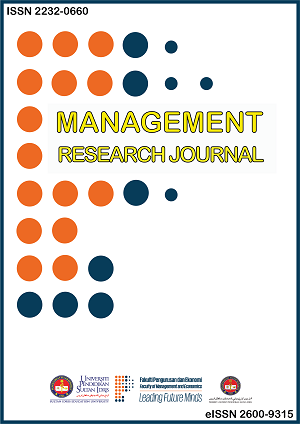Nosacq-50: Assessment of Safety Climate Among Management Workers and Frontliners in Health Offices in The State of Terengganu, Malaysia
DOI:
https://doi.org/10.37134/mrj.vol13.1.7.2024Keywords:
Safety Culture, Safety Climate, Nordic Safety Climate Questionnaire, managementAbstract
Various aspects need to be considered to ensure that the workplace has a positive safety culture. Therefore, this study examines the differences in safety climate among management and frontline workers at district health offices (PKD) in Terengganu, Malaysia. A safe working environment can prevent workplace accidents and enhance the safety culture at the workplace. In Malaysia, workplace accidents that result in the loss of workers' lives still occur. Therefore, it is essential to study the safety climate and improve the safety culture in workplaces across Malaysia. This study involves two District Health Offices, namely Kuala Nerus District Health Office and Kuala Terengganu District Health Office. A total of 50 respondents, comprising staff working in the Vector Unit at each District Health Office, participated in the study. Data from respondents were obtained using the NOSACQ-50 Safety Climate Questionnaire (Nordic Safety Climate Questionnaire), which was distributed to gather demographic information and to answer questions related to safety climate. The findings of the study indicate that the overall safety climate in both PKDs is relatively low. The assessment shows that Dimension 5, which pertains to the priority of safety and the non-acceptance of risks by workers, is at the lowest level (2.15) and requires significant improvement. Meanwhile, the other five dimensions, namely Dimensions 1, 2, 3, 4, and 7 (Management’s commitment to and competence in safety, Management’s empowerment of safety aspects, Management’s safety justice, Workers’ safety commitment, and Workers’ trust in the effectiveness of the safety system) are also at relatively low levels and need specific enhancements. Lastly, Dimension 6, which relates to communication, learning, and trust in colleagues' competence, is at a relatively good level. Therefore, management must further improve the quality of occupational safety management so that the safety climate reaches an optimal level and ensures a positive safety culture, especially in health facilities generally.
Downloads
References
Amirah, N. A., Amin, A., Muda, S., Talaat, W. I. W., & Rashid, N. M. N. N. M. (2017). Relationship Between Behavioral Aspects and Safety Culture in the Peninsular Malaysia Manufacturing Industry. World Applied Sciences Journal, 35(9), 1880–1884. https://doi.org/10.5829/idosi.wasj.2017.1880.1884
Clarke, S. (2013). Safety leadership: A meta-analytic review of transformational and transactional leadership styles as antecedents of safety behaviours. Journal of Occupational and Organizational Psychology, 86(1), 22–49. https://doi.org/10.1111/j.2044-8325.2012.02064.x
Cooper Ph.D., M. D. (2002). Towards a model of safety culture. Safety Science, 36(2), 111–136. https://doi.org/10.1016/s0925-7535(00)00035-7
F.W. Guldenmund. (2000). The nature of safety culture : a review of theory and research. Safety Science, 34, 215–257. https://doi.org/10.1016/S0925-7535(00)00014-X
Flin, R., Mearns, K., Connor, P. O., & Bryden, R. (2000). Measuring safety climate : identifying the common features. Safety Science, 34(July 1998).
Glendon, A. I., & Litherland, D. K. (2001). Safety climate factors, group differences and safety behaviour in road. Safety Science, 39(3).
Griffin, M. A., & Neal, A. (2000). Perceptions of safety at work: a framework for linking safety climate to safety performance, knowledge, and motivation. Journal of Occupational Health Psychology, 5(3), 347–358. https://doi.org/10.1037/1076-8998.5.3.347
Juhari, M. L., & Arifin, K. (2020). Pembentukan model faktor bahan dan peralatan sebagai penyebab kemalangan dalam industri pembinaan Mass Rapid Transit. Malaysian Journal of Society and Space, 16(2), 124–138. https://doi.org/10.17576/geo-2020-1602-10
Kines, P., Lappalainen, J., Mikkelsen, K. L., Olsen, E., Pousette, A., Tharaldsen, J., Tómasson, K., & Törner, M. (2011). Nordic Safety Climate Questionnaire (NOSACQ-50): A new tool for diagnosing occupational safety climate. International Journal of Industrial Ergonomics, 41(6), 634–646. https://doi.org/10.1016/j.ergon.2011.08.004
Molenaar, K. R., Park, J. Il, & Washington, S. (2009). Framework for measuring corporate safety culture and its impact on construction safety performance. Journal of Construction Engineering and Management, 135(6), 488–496. https://doi.org/10.1061/(ASCE)0733-9364(2009)135:6(488)
Neal, A., & Griffin, M. (2004). Safety climate and safety at work. In: Barling, J., Frone, M. R. (Eds.), The Psychology of Workplace Safety. Psychological Association, United States.
Noor Arzahan, I. S., Ismail, Z., & Yasin, S. M. (2022a). Safety culture, safety climate, and safety performance in healthcare facilities: A systematic review. Safety Science, 147, 105624. https://doi.org/10.1016/j.ssci.2021.105624
Noor Arzahan, I. S., Ismail, Z., & Yasin, S. M. (2022b). Safety Performance Model in Malaysian Paramedic Training Institute in Malaysia. Injury Prevention, 28(Suppl 2). https://doi.org/10.1136/injuryprev-2022-safety2022.41
Rahman, F. A., Arifin, K., Abas, A., Mahfudz, M., Basir Cyio, M., Khairil, M., Ali, M. N., Lampe, I., & Samad, M. A. (2022). Sustainable Safety Management: A Safety Competencies Systematic Literature Review. Sustainability, 14(11), 6885. https://doi.org/10.3390/su14116885
Siti Fatimah Bahari. (2011). An Investigation of Safety Training , Safety Climate and Safety Outcomes : A Longitudinal Study in a Malaysian Manufacturing Plant.
Srinivasan, S. (2012). the Impact of 5S on the Safety Climate of Manufacturing Workers. Manufacturing System, 1(December), 1–58.
Wachter, J. K., & Yorio, P. L. (2014). A system of safety management practices and worker engagement for reducing and preventing accidents: An empirical and theoretical investigation. Accident Analysis & Prevention, 68, 117–130. https://doi.org/https://doi.org/10.1016/j.aap.2013.07.029
Wu, T.-C., Chen, C.-H., & Li, C.-C. (2008). A correlation among safety leadership, safety climate and safety performance. Journal of Loss Prevention in the Process Industries, 21(3), 307–318. https://doi.org/https://doi.org/10.1016/j.jlp.2007.11.001
Yu-Jung, L., Jin-Luh, C., Shyh-Yueh, C., Ming-Tsai, H., & Chen-Hua, W. (2013). Evaluation of Safety Performance in Process Industries. Process Safety Progress, 25(4), 326–330. https://doi.org/10.1002/prs
Yule, S., Flin, R., & Murdy, A. (2007). The role of management and safety climate in preventing risk-taking at work. International Journal of Risk Assessment and Management, 7(2), 137–151. https://doi.org/10.1504/IJRAM.2007.011727
Zohar, D. (1980). Safety climate in industrial organizations: Theoretical and applied implications. Journal of Applied Psychology, 65(1), 96–102. https://doi.org/https://psycnet.apa.org/doi/10.1037/0021-9010.65.1.96
Downloads
Published
How to Cite
Issue
Section
License
Copyright (c) 2024 Mohd Azwan bin Ali, Zaman bin Awang Sulaiman, Mohd Roslan bin Rahmat, Intan Suraya binti Noor Arzahan

This work is licensed under a Creative Commons Attribution-NonCommercial-ShareAlike 4.0 International License.





